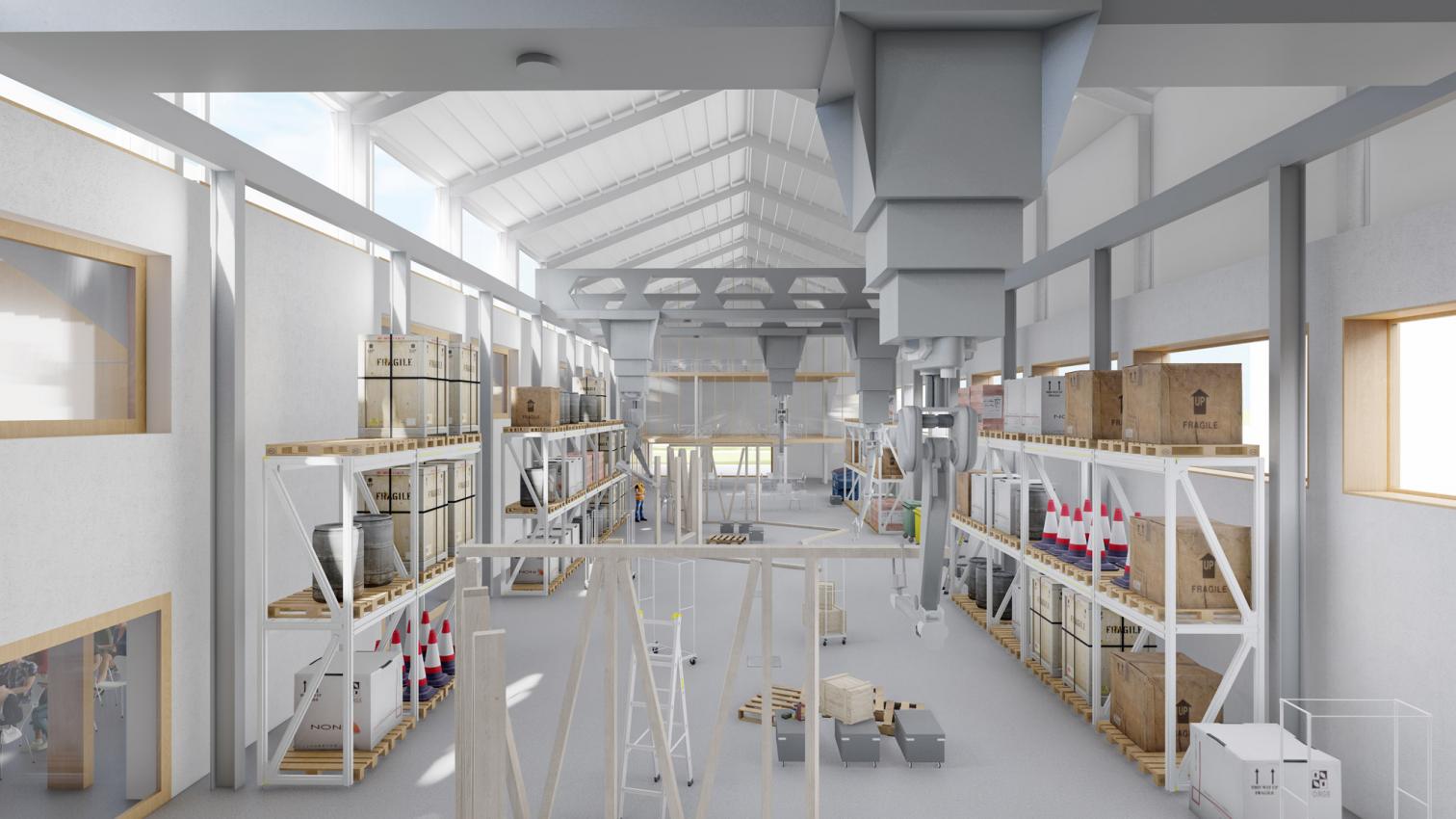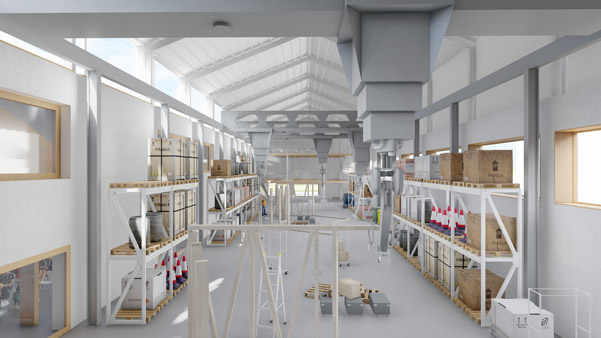BAI, an Optimistic Response to Reality

The BAI Institute aspires to be a response and an instrument of action that combines the reality of the practice of architecture today – at least in the countries we include under the heading of ‘developed’ – and the situation of the teaching of architecture and construction, as well as the role to be played by the profession and the sector in the context of the social, economic, and employment reality of our country. A rapidly changing reality, which defines a new determining framework for the practice of architecture and which, in most cases, is imposed regardless of the meaning of what this discipline is.
It is only fair to acknowledge that this confluence around which the BAI has arisen has had the necessary support - both in terms of diagnosis and objectives and instrument - from the Spanish Government and the Government of Navarre, which have provided financial, legal, and administrative instruments for an Institute that has been born with a vocation for rigor and excellence, and welcomes any improvement that helps to achieve these objectives.
A Proposal from Reality
The model of artisan architecture as conceived in Europe, and especially in Spain, seems to have come to an end. Architecture as a discipline that articulates and solves problems based on the complex reality it serves is disappearing. This way of doing things, where the architect assumes a role of synthesis, of integrator of knowledge, only survives in a recognizable way in less wealthy countries where the context, sometimes harsh and difficult to escape from, is imposed by necessity and where the limitations derived from scarcity are ultimately more stimulating for architecture than the excess, regulation, and order established in the richer ones.
In these, architecture has become yet another discipline subjected to the world of specialization - perhaps this is the change and the drift that most intensely attacks the essence of architecture today -, and where the creative act that architecture signifies has been replaced by another, only productive one, derived from an invasive corporate system that, little by little, has been impregnating most of the interventions in the city and in architecture today. It is in the nature of the corporate system to replace the creative and synthetic identity of the architectural project, which implies the architect's leadership, with a reality in which our work is a subsidiary part, as an ‘aesthetic advisor,’ of a process mainly based on financial – not economic – criteria, or on bureaucratized procedures that are, in the end and paradoxically, profoundly inefficient. Standardization takes precedence over risk: standardization over excellence. And so, architects who are critical and claim a role as such – sometimes working more than what is required of them – turns out to be a nuisance in the end.
Alongside the reality described above, we are going through years in which the increase in regulatory and bureaucratic zeal has caused a notable lack of efficiency without this having led to a rise in quality architecture. And this process has occurred both in public administration and in private structures, which have copied its procedures. The regulations that want to rule everything end up creating a context of conceptual and intellectual poverty whose only objective is the fulfillment of these minimums, eventually transformed into maximums.
This complex situation results in a reality where many architects are tempted to develop a reductive architecture in which the only concern is the appearance of the architectural object. In the end, it is a game of action and reaction – feedback – that eliminates from the scene the architecture of value, carried out with due seriousness and intensity. As a reflection of society's demands, schools of architecture are adding to this situation by striving, on the one hand, to diminish the polytechnic condition of architectural training and, on the other, to promote exclusive specialization as a supposed response to the market’s demands.
Instead of intensifying a training that would allow us to continue at the forefront of the architectural project, the alternative for today's graduate is, increasingly, either to become a sort of ‘aesthetic facade specialist’ who will act as part of a group that distributes decisions in which architecture is just another speciality, or to repeat ad nauseam a calligraphy of their own, defined as successful by the market and reproduced as ‘identity’ regardless of the specific circumstances of place and time. This situation has resulted – especially since the implementation of the Bologna plan – in schools where the level of demand has decreased substantially and where the academic programs largely dispense with essential training for the architect, such as polytechnic disciplines or, in the humanities, the study of the history of ideas and architecture, as well as knowledge linked to the social sciences, which are fundamental to help understand the contemporary context.
An optimistic proposal
BAI (National Center for Innovation and Industrialization of Architecture and Construction) seeks to be an optimistic response to the situation described in the previous section. A response that pursues recovering the essential values and responses expected of our work. The essence of BAI is based on a reaffirmation of architecture that takes into account the contexts in which it is produced, and reasserts the work of architects beyond administrative and financial impositions that have little to do with the fundamentals of architecture. This is the only way to maintain the identity of the profession and the discipline, without ceasing to serve society. It is not a question of being diluted in a magma where the cultural and quality fact ceases to be the most important thing and is diluted in the constructive or speculative; on the contrary: we want, from the instruments and knowledge at our disposal, to make better architecture for each specific reality.
BAI is not just a teaching institute. One of its main objectives is indeed the revision of a large part of the current way of teaching architecture and construction, but it is in the nature of its contents and in the way of organizing access to them that the singularity and value of the new Institution's commitment lies, as an instrument that claims an intense training in contents and is demanding in results. This is not just another postgraduate school; rather, it approaches with a unique and different type of training of excellence. Hence our commitment to combine teaching with research in areas that, due to their specific nature, are of interest. BAI is therefore simultaneously a research and teaching institute: we learn by researching. To this end, in instrumental terms, it will work with laboratories where the architectural proposals are built on a real scale and, more importantly, upon projects that will actually be built. All this – together with the reduced group of students and the outstanding teaching staff – will involve an immersion in the debate and development of architecture. Basically, the idea is to transfer the way of working and thinking in a studio to the teaching environment, always with intellectual ambition and a vocation for excellence.
The BAI Institute makes the command of the latest techniques and the collaboration with industries a basic instrument of its work. This is, strictly speaking, nothing new: architecture has always worked with craftsmanship and industry, and this relationship has been the origin of the generation of solutions and ideas of the first order, a process of exchange that has always progressed positively. The people behind BAI's ideology see precisely in the reclamation of architectural materiality and the construction techniques that work with it an indisputable starting point to organize the discussion – along with the training and qualification – in today's architectural panorama. A useful mechanism to re-evaluate training that will enable us to respond to certain problems beyond the current reductionism that transforms architecture into a liquid space in which anything goes.
It is true that technique and industrialization are particularly important for BAI, but it is no less true that our aim is not to turn them into objectives in themselves, but into instruments to transform reality. Ignorance of contemporary techniques limits the ability to propose creative solutions but, to be effective, they must function as learning and management tools that in no way go against the cultural and social dimension of architecture.
Architecture is not only an effort of reason and description, but also an effort of feeling and intuition: we are part of a culture, we work in specific contexts, and we aspire to create lasting meanings. For this reason, the intense polytechnic training and the use of the most advanced technical systems will take place in a context in which the humanistic and social training that is essential to define the substratum on which architecture develops are strengthened. Thus, the BAI program includes three compulsory modules, with a structuring character: ‘Environment-Construction-History,’ ‘Thought-Critique-Design,’ and ‘Society-Economy-City.’ Complemented and enriched by the ‘Design and New Technologies’ module, these modules will constitute the wealth of knowledge that will eventually materialize and be synthesized in the ‘Architecture Project.’ BAI, therefore, offers a polytechnic training that enhances the capacity for synthesis that constitutes the identity of the architect: far from being just a ‘technical institute,’ BAI combats the excessive spirit of specialization and compartmentalization – and, with them, the reduction of skills – that seem to govern the making and teaching of architecture today.
It is only possible to undertake such an ambitious project with optimism and effort. This is not a project of the past, but of the present and future: it seeks solidity and rigor in training and work as a response to a changing world in which perhaps these two activities – especially teaching – have been invaded by the ‘anything goes’ of attitudes void of objectives and foundations.
Some Characteristics of BAI
BAI is an acronym corresponding to the National Reference Center for Innovation and Industrialization of Architecture and Construction. The fact that it is set up as a national institution only expresses the ambition and importance of its objectives. The Institute's work and research, appropriately disseminated, aims to be a reference at national and international level. This presence will materialize both in the world of teaching – its results and experiences can be applied in other academic institutions – and in the development of research that can have a subsequent effect on different areas of architecture and its construction.
The Institute is committed to internationalization both in terms of the students in the different graduating classes and of the professors and researchers invited to join its faculty and development team. Contact with institutions of a similar nature is a part of this internationalization of knowledge, which is indispensable today. In this endeavor, exchange programs and internships will be organized at the highest level. Likewise, the collaboration between different disciplines is part of the nature of BAI, a fact that is consubstantial to architecture, but which in our case aspires to transcend the condition of a recurrent and contentless saying to become the basis of all research and teaching programs, not only because of the characteristics of the researcher-teachers, but also because of the student body itself, as the teaching will also be open to students from other training backgrounds, not specifically in the field of architecture.
But interdisciplinarity is also conceived from an instrumental perspective, with the fundamental objective of making better architecture. Architecture can in no way be the linear sum of different opinions or specialities; on the contrary: these must be articulated around a structuring element – the project – promoted and directed by architecture as an exercise in synthesis. This objective of interacting as much as possible with other areas of knowledge and agents will be materialized, on the other hand and from the outset, in the collaboration with a series of national and international industries, which will be part of the ‘BAI Industrial Board,’ accessed exclusively through the merits of the research curriculum and the demonstrated capacity to collaborate with architecture. BAI is not looking for ‘catalogue’ solutions, but open and specific solutions that are the result of an enriched collaboration between industry and project, and of the work of students and professors in an endeavor to solve real problems.
BAI's research and training work is committed to reality. It is true that there are other institutes with similar advanced technology; however, the general trend in these institutes is for the techniques to be, from the outset, ends in themselves, which brings with it the attitude of simply seeking to do the most difficult ‘thing’ or the most sophisticated form. We are already familiar with this way of doing and thinking, and this endorses BAI's commitment to reality: there is no more attractive, suggestive, and creative opportunity than to respond to real problems. Far from acting as a burden, reality is the challenge we must face with a serious and exhaustive knowledge of the means at our disposal. This is why BAI insists on the social condition of architecture and its capacity to improve our natural, economic, and distributive environment.
The following chapters of this publication describe the practical contents of the National Institute of Innovation and Industrialization applied to Architecture and Construction, offering as well precise information on the organization and functioning of the center. They also advance the contents and objectives of the different modules and areas of research, outlining the ideas behind an adventure that hopefully will contribute to improving a discipline that can in no way become a privilege. On the contrary: quality architecture and cities are a right.




